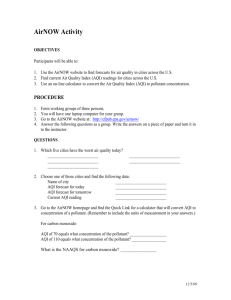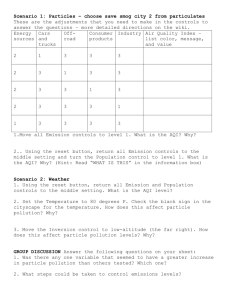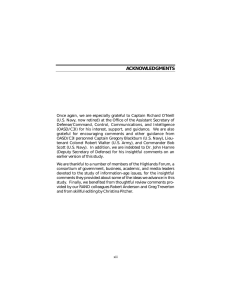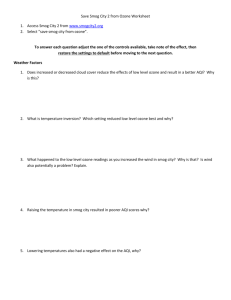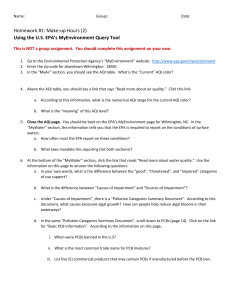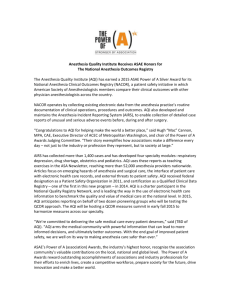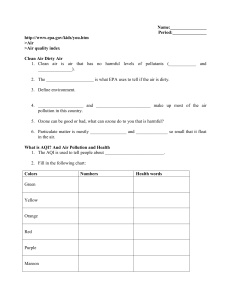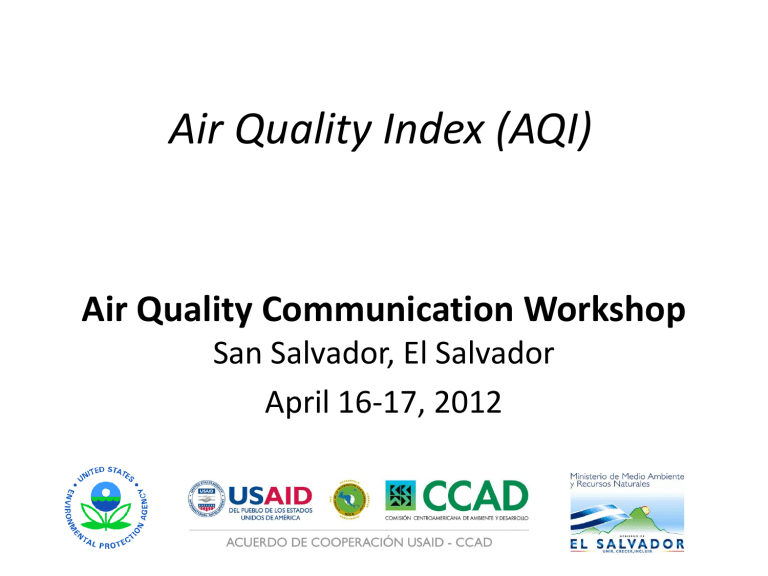
Air Quality Index (AQI) Air Quality Communication Workshop San Salvador, El Salvador April 16-17, 2012 How Do People Know What Particle Pollution Levels Are In their City or Country? • Air quality monitors measure PM2.5 and PM10 concentrations in g/m3 • Local, regional, and national governments decide how to disseminate monitor measurements to the public • Preferred way to communicate is via a color-coded Air Quality Index (AQI) that is easy for the public to understand 2 What is the Air Quality Index? • • • • Index for reporting air quality Color is key for communication Ranges from 0 to 500 (no units) Provides indicator of the quality of the air and its health effects • 101 typically corresponds to the level that violates the national health standard 3 Air Quality Index (AQI) AQI Value 0 - 50 AQI Category AQI Color Good Green 51 - 100 Moderate Yellow 101 - 150 Unhealthy for Sensitive Groups Orange 151 - 200 Unhealthy 201 - 300 Very Unhealthy 301 - 500 Hazardous Red Purple Maroon Daily Air Quality Standard 4 AQI Health Messages AQI Value 0 - 50 Health Message AQI Color None Green Unusually sensitive people should reduce prolonged or heavy exertion Yellow Sensitive groups should reduce prolonged 101 - 150 or heavy exertion Orange 51 - 100 151 - 200 Sensitive groups should avoid prolonged or heavy exertion; general public should reduce prolonged or heavy exertion Sensitive groups should avoid all physical 201 - 300 activity outdoors; general public should avoid prolonged or heavy exertion Red Purple Everyone should avoid all physical activity 301 - 500 Maroon outdoors 5 AQI Video 6 Actions People Can Take to Protect Their Health When Particle Pollution is High • Avoid exercising or working outdoors for long periods of time • Choose less strenuous outdoor activities • Avoid exercising near busy roads • Postpone outdoor recreational activities • Avoid sources of particles indoors: – Wood-burning stoves – Fireplaces – Candles 7 Example of How Athletics Coaches Use the AQI to Protect Children’s Health • “I coach youth baseball and I do not have strenuous practice sessions on bad air quality days.” • “Our school cancels practices for outdoor sports activities during air quality episodes, when the AQI exceeds the Code Yellow range.” • “I coach a boys’ soccer team, and I cancel practice when the AQI reaches 100.” 8 Actions People Can Take to Reduce Particle Pollution • Conserve electricity • Use dry, seasoned wood for fireplaces and stoves • Carpool, use public transportation, bike, or walk when possible • Avoid idling of car engines for long periods of time • Keep car tires properly inflated • Maintain car, boat, and other engines to ensure maximum fuel efficiency 9 Communicating via AQI is Effective • 52% of people in the U.S. had heard of AQI Code Orange or Code Red air quality days (2002) • 46% of people in the U.S. who knew about the AQI had reduced their exposure to air pollution on Code Orange and Code Red air quality days (2002) • 4-7% reduction in pediatric hospital admissions for asthma in the U.S. due to reduction in children’s exposure on poor air quality days 10 U.S. EPA PM2.5 AQI AQI Value 24-hr Average PM2.5 Concentration ( g/m3) 0 - 50 0 - 15.4 Moderate 51 - 100 15.5 - 40.4 USG 101 - 150 40.5 - 65.4 Unhealthy 151 - 200 65.5 - 150.4 Very Unhealthy 201 - 300 150.5 - 250.4 Hazardous 301 - 500 250.5 - 500.4 AQI Category Good 11 U.S. EPA PM10 AQI AQI Value 24-hr Average PM2.5 Concentration ( g/m3) 0 - 50 0 – 54 Moderate 51 - 100 55 – 154 USG 101 - 150 155 – 254 Unhealthy 151 - 200 255 – 354 Very Unhealthy 201 - 300 355 – 424 Hazardous 301 - 500 425 – 604 AQI Category Good 12 Example of PM2.5 Monitor Measurements Reported using the AQI in the U.S. 1 – 50 Good 51 – 100 Moderate 101-150 USG 151 – 200 Unhealthy 201 – 250 Very Unhealthy 13 Example of IMECA in Mexico City 14 Índice Metropolitano de la Calidad del Aire http://www.calidadaire.df.gob.mx/calidadaire/index.php?opcion=2&opcioninfoproductos=22 15 Example of Possible Regional Air Quality Measurements Reported using the AQI 1 – 50 Buena 51 – 100 Normal 101-150 Mala 151 – 200 Muy Mala 201 – 250 Extremadamente Mala 16 Possible PM2.5 AQI Categories for Region Current USEPA Category AQI Value Buena Proposed USEPA WHO-based PM2.5 ( g/m3) g/m3 range PM2.5 ( g/m3) g/m3 range PM2.5 ( g/m3) g/m3 range 0 - 50 0 - 15.4 15.5 0 - 15.4 15.5 0 - 10.4 10.5 Normal 51 - 100 15.5 - 40.4 25 15.5 - 35.4 20 10.5 - 25.4 15 Mala 101 - 150 40.5 - 65.4 25 35.5 - 55.4 20 25.5 - 40.4 15 Muy Mala 151 - 200 65.5 - 150.4 85 55.5 - 140.4 85 40.5 - 125.4 85 Extremadamente Mala >200 PM2.5 Standard ( g/m3) >150.4 >140.4 1997 USEPA NAAQS daily 65 annual 15 >125.4 2006 USEPA NAAQS daily 35 annual 15 2007 WHO Guidelines daily 25 annual 10 17 Comparison of Possible PM2.5 AQI Categories 200 175 PM2.5 ( g/m3) 150 125 100 75 1997 US EPA Daily Standard 50 2006 US EPA Daily Standard 2007 WHO Daily Guideline 25 0 1997 US EPA Annual Standard 2006 US EPA Annual Standard Current US EPA AQI Proposed US EPA AQI 2007 WHO Annual Guideline Suggested WHO AQI 18 PM2.5 AQI Used by University of Panama (Current USEPA AQI) Valor ICA Concentración PM2.5 Promedio en 24 Horas ( g/m3) 0 - 50 0 - 15.4 Moderada 51 - 100 15.5 - 40.4 Dañina para Personas Sensibles 101 - 150 40.5 - 65.4 Dañina 151 - 200 65.5 - 150.4 Muy Dañina 201 - 300 150.5 - 250.4 Peligrosa 301 - 500 250.5 - 500.4 Categoría ICA Buena 19 PM2.5 AQI Used by MARN 20 Background and History in the U.S. • Prior to 1976: – 55 cities used 14 different indices – Different cautionary messages – Confusing to the public • In 1976: – U.S. Clean Air Act required U.S. Environmental Protection Agency (EPA) to establish a national air quality index – EPA established the Pollutant Standards Index (PSI) • From 1976 to 1998, EPA and U.S. cities used the PSI that covered: – – – – – Ground-level ozone Particulate matter Carbon monoxide Sulfur dioxide Nitrogen dioxide 21 Background and History in the U.S. • In 1999, EPA revised the PSI – Updated the index – Changed the name to Air Quality Index (AQI) – Received extensive input from: • State/local experts (outreach, health, and air quality) • General public (8 focus groups in major U.S. cities) • Workshops • Ozone and particle pollution standards were added: – 8-hour O3 standard – 24-hour PM2.5 standard • AQI has been used internationally in China, Mexico, Chile, and Brazil 22 Advantages of the AQI • AQI is more successful than PSI in many ways: – Name is better – “Quality” Index versus “Pollutant Standard” Index – Simple categories (Good, Moderate, etc.) – Colors are key for communication • Ability to visualize pollution via maps • Association between colors and health – Uniformity – AQI is standard and consistent across the United States 23 Calculating AQI Values • Calculate the AQI using pollutant concentration data in the following equation: AQI PM obs PM min AQI max PM max PM min AQI min AQI min PMobs = observed 24-hour average concentration in µg/m3 PMmax = maximum concentration of AQI color category that contains PMobs PMmin = minimum concentration of AQI color category that contains PMobs AQImax = maximum AQI value for color category that corresponds to PMobs AQImin = minimum AQI value for color category that corresponds to PMobs 24 Example AQI Calculation Calculate the AQI corresponding to a 24-hr PM2.5 concentration of 31 g/m3 AQI Value PM2.5 Breakpoints ( g/m3) 0 0 51 15.5 101 40.5 151 65.5 201 150.5 AQI PM obs PM min x( AQI max AQI min ) PM max PM min AQI 101 51 x(31 15.5) 40.5 15.5 AQI min 51 AQI 82 25 Summary • The Air Quality Index (AQI) is a simple, color-coded, unitless index that is an effective way to communicate air pollution concentrations to the general public • The AQI provides an indication of the quality of the air and its health effects • Options exist for scaling the AQI categories to PM2.5 and PM10 concentration values ( g/m3) – Examples from El Salvador (MARN) and Panama (UP) • Simple equation can be used to convert concentration values ( g/m3) to AQI values (unitless) 26
